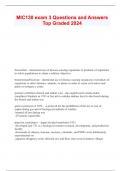Summary
Summary Biology A2 level 'variation and evolution' notes (WJEC)
Biology A2 level 4.4 'variation and evolution'. These notes were formulated using class notes, the WJEC study guide and past papers. These notes helped me to achieve an A* at A level biology!
[Show more]












